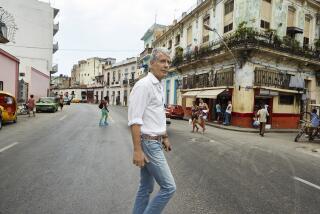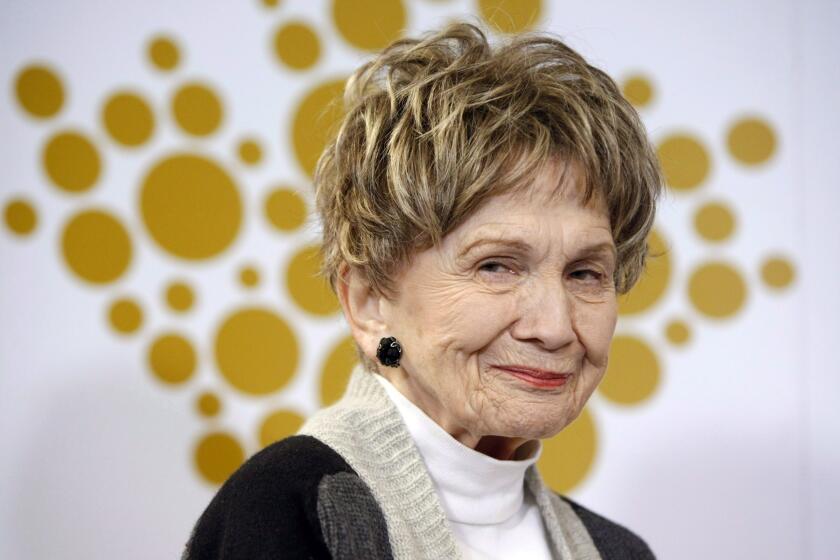Tracking Chandler’s every move
Raymond Chandler has been called the major social historian of Los Angeles, and perhaps one reason he wrote about the city so well is that he knew it from so many different angles: He lived in more than 30 rented houses and apartments in and around L.A. in as many years.
Reading his letters, one can’t help noticing how often the addresses atop them changed. Recently I decided to track down all these places as part of the research for a book I’m writing on Chandler and his wife, Cissy. I wanted to see if I could discover any trace of their lives, but I also wanted to answer two questions: Why did they move so often -- sometimes two or three times a year? And what effect did those moves have on his writing?
One thing we know is that Chandler and his wife were very fussy people. It was easy for them to find something wrong with wherever they lived. More to the point, Chandler was a restless person whose many childhood moves with his mother -- first from the Midwest to England, and then to various residences in London -- set an early pattern of restlessness.
“I’ve always been a gypsy at heart, accustomed to a more nomadic lifestyle,” he once wrote to English novelist W. Somerset Maugham. “I seem to require an ever-changing scene and new people.... I’m constantly seeking new places to stimulate me.”
He wrote so perceptively about all segments of L.A. society -- cops and crooks, starlets and chiselers, the rich and the poor -- in part because he’d moved so freely around the city. And he used the locales in his stories.
However, many of the places where Chandler lived in L.A. don’t exist anymore. At least half have been replaced by something else. It seemed to me that in my search, I was discovering how Los Angeles is a city of architectural disposability, forever in the process of erasing its rather recent past.
Chandler’s frequent moves were not the only unusual aspect of his life. Another was his unconventional marriage to a much older woman. He was 35 when he wed the newly divorced Cissy Pascal in 1924. Cissy was 53, although she listed her age as 43 on their marriage certificate, and it’s generally believed that only later did Chandler discover he’d married a woman not eight years older, but 18.
Over the years, the couple grew increasingly reclusive and moved to places near downtown (many along the Wilshire corridor near the old Ambassador Hotel) and to Santa Monica, Brentwood, Redondo Beach, Hollywood, Pacific Palisades, the Fairfax district, Arcadia, Monrovia, mid-Wilshire and Silver Lake, plus Riverside, Big Bear, Idyllwild and Cathedral City.
Chandler began his life in L.A. in 1912, on Bonnie Brae Street, as the houseguest of the Warren Lloyd family -- wealthy Angelenos he’d met on the boat that brought him to America at the age of 24. The Lloyds convinced him that L.A. was a thriving city and suggested they’d help him get settled. Eventually Chandler took them up on their offer, and Warren found him a job as an accountant at the Los Angeles Creamery.
The Lloyds occupied a large house at 713 Bonnie Brae St., not far from MacArthur Park. What was once a fashionable neighborhood has become a hard-core urban residential area, with only a few Victorian-era mansions still standing. Where the Lloyds lived are now three small storefronts -- a Latino market, a hair salon and an evangelical church.
Chandler eventually moved to an apartment of his own, at the top of Angels Flight. His mother, Florence, came from England to live with him. The Angels Flight apartment is long gone, a victim of downtown redevelopment. So is the little bungalow court at 311 S. Loma Drive, where Chandler and his mother moved next. It’s been replaced by a large low-income housing project.
But their next residence is still there, at 127 S. Vendome St., just east of Vermont between Beverly Boulevard and 2nd Street. This is where Cissy and her then husband, composer-musician Julian Pascal, were living when Chandler met the couple at a musical evening at the Lloyds’ and fell in love with Cissy. It’s also where his mother stayed while Chandler was away in France fighting in World War I, and where he lived for a while upon his return.
Shortly after he came back from the war, Chandler and Cissy declared their love for each other and Cissy divorced her husband. Chandler’s mother did not approve of their relationship, however, and so they lived in separate apartments -- Chandler and his mother in Redondo Beach, and Cissy in nearby Huntington Beach, until Chandler’s mother died four years later and they were able to marry. They moved back to the city center, to a double house at 2863 Leeward St., near Hoover and 8th streets -- a house that no longer exists.
At this time, Chandler was working as a senior accountant for the Dabney Oil Syndicate. The couple’s next move was to 700 Gramercy Place, near Melrose Avenue, a two-story apartment building now covered with iron bars and a security gate. They stayed here less than a year, then moved to 2315 W. 12th St. But before long, they had moved again, to 1024 N. Highland Ave., a Spanish-style stucco fourplex that appears almost unchanged today.
It was now 1928, and the Chandlers’ marriage had begun to show signs of strain. Chandler was drinking heavily and having an affair with his secretary. He moved out of the apartment on Highland. In 1931 he was fired from Dabney Oil for drinking and womanizing.
At this point, Chandler began to remake himself into a writer. He stopped drinking, and Cissy took him back. They moved to Santa Monica, then a cheap place to live. He began reading the pulp crime magazine Black Mask and teaching himself to write.
They also became even more reclusive. To save money, they put their furniture in storage and rented furnished rooms, getting by on meager savings. At the time, a one-bedroom apartment cost $50 to $60 a month. From Santa Monica, they moved to an apartment on Greenwood Place, just off Vermont Avenue near Fountain Avenue.
At this address on a quiet street, I find that the lovely building housing nine apartments is still standing, “El Pueblo” painted over the graceful little archway leading to the courtyard. The place feels like old L.A., surrounded by lush greenery that gives off a deep, watery light. I quietly open a gate and creep back through a darkened archway that opens onto a little courtyard.
As I head back through the archway, I notice a row of old metal mailboxes, long unused. There, on the last box, is the name Chandler, written on an old, yellowed piece of paper. Did Chandler write that, I wonder, and has it been here all these years? Or did someone leave it more recently, as an homage to the writer who once lived here?
On the way out, I bump into a young woman named Lisa. When I tell her about my interest in Chandler, she agrees to let me look inside her place, the apartment that the writer occupied.
The apartment hasn’t been remodeled. It’s a small, dark, one-bedroom unit with low ceilings -- the kind of place where you’d expect a writer to live. Here Chandler worked on his first stories, “Blackmailers Don’t Shoot” and others. Lisa tells me she moved to L.A. from the Midwest. She’s pretty and fresh-faced, like a would-be actress -- the kind of woman Chandler might have written about, one who’d let strangers into her apartment because she’s trusting, or didn’t know any better.
My search continued over many weeks. With the help of a Thomas Guide, I located the duplex on Resedale Avenue in Silver Lake that looked like a little French country cottage, where a small balcony draped with bougainvillea must have afforded a pleasant place for Cissy and Ray to take their morning coffee.
In Arcadia, where Chandler awaited publication of “The Big Sleep,” a faux-Bavarian condo complex stands on the site where he once lived. And in nearby Monrovia, where he began “Farewell, My Lovely,” the same story: a cheap-looking apartment building had replaced whatever was there before.
From Monrovia, the Chandlers moved to 857 Iliff St. in Pacific Palisades, and here he worked on “The High Window” in an unpretentious little house now dwarfed by its remodeled neighbors. It was from this address that Chandler wrote to his mystery writer friend Erle Stanley Gardner, “Good God, we’ve moved again.” To another friend, he confided, “It must be nice to have a home. We haven’t had one in so long that I look back with a touch of nostalgia to any place we’ve stayed in as long as six months.”
With the success of his first novels, the Chandlers began renting cabins in Big Bear and Idyllwild for the summer, and apartments in Cathedral City and La Jolla for the winter. Income from his first screenplay, “Double Indemnity” (on which he collaborated with Billy Wilder), meant they could afford houses in better neighborhoods, such as the place on a quiet cul-de-sac in Brentwood, at 12216 Shetland Lane, a classic bungalow with a red-tiled roof that has been pleasingly restored, with an enclosed front garden and an inviting porch.
The last place they rented in L.A. was a graceful one-story stucco house at 6520 Drexel Ave., near Fairfax Avenue, that looks very much like it must have when the Chandlers lived there (the neighborhood seems to have gone uphill). Cissy, then 74, suffered from a chronic lung condition and spent much of the day sedated. Ray, at 58, was working at Paramount Studios on a script for producer and director John Houseman, who used to take Sunday drives up the coast with them and once offered this description of the couple: “In Hollywood, where the selection of wives was frequently confused with casting, Cissy was something of a phenomenon. Ray’s life had been hard. He looked 10 years older than his age. His wife looked 20 years older than he did and dressed 30 years younger.”
For many years, Cissy had longed to buy a place in La Jolla. Finally, in 1946, having grown tired of both the film industry and Los Angeles (“It is no longer the part of me it once was,” Chandler wrote), the couple bought a place on Camino de la Costa, just south of the charming village, ending 30 years of a peripatetic lifestyle. The house was new, a one-story ranch built around a courtyard with a sweeping view of the ocean and the curving coastline.
The house where they spent their last years has changed, but not as noticeably as its neighbors. It’s about to be completely remodeled, but the developer has agreed to retain parts of Chandler’s study.
To keep writing, Chandler may have needed what his biographer Frank McShane called “the romance of the ineffable.” We may not know what motivated all of the moves, but I do think they affected his work -- books that have stood the test of time, even if places where he and Cissy once lived have not. All that moving around fed his imagination and gave him more vistas to write about, more stories to tell.
After tracking down all the residences I could, I returned to the apartment on Greenwood Place where I had seen Chandler’s name on the mailbox . I found that the slip of paper had so faded that the name was no longer legible, confirming my suspicion that it had not survived five decades but had been put there more recently. Even this trace of his life was erased, leaving part of the mystery of Raymond Chandler intact.
Judith Freeman’s most recent novel is “Red Water.”
More to Read
Sign up for our Book Club newsletter
Get the latest news, events and more from the Los Angeles Times Book Club, and help us get L.A. reading and talking.
You may occasionally receive promotional content from the Los Angeles Times.









